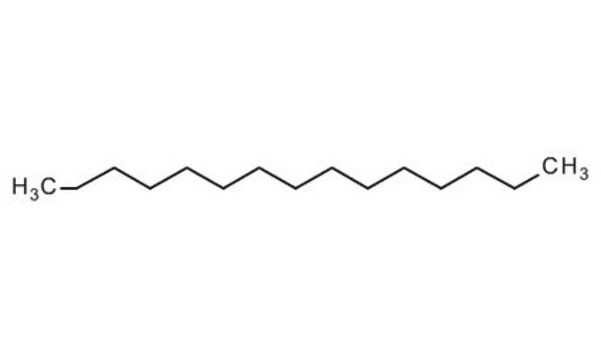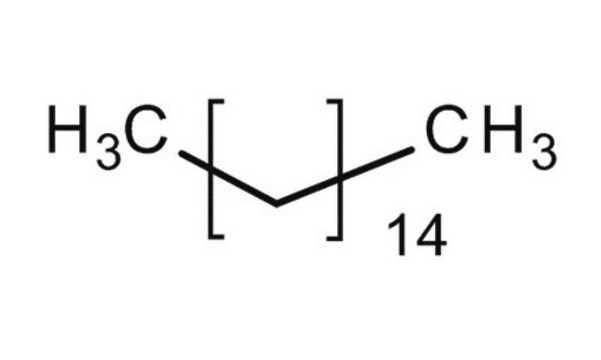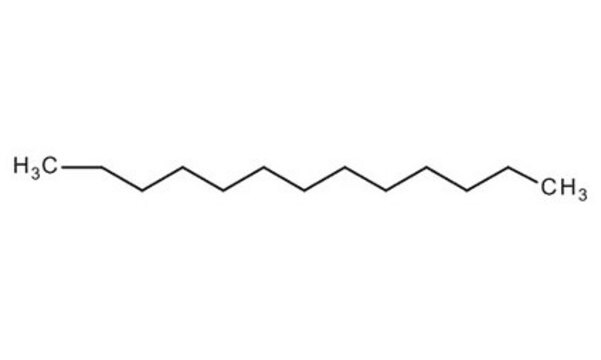All Photos(2)
About This Item
Linear Formula:
CH3(CH2)13CH3
CAS Number:
Molecular Weight:
212.41
Beilstein:
1698194
EC Number:
MDL number:
UNSPSC Code:
12352100
PubChem Substance ID:
NACRES:
NA.22
Recommended Products
vapor density
7.4 (vs air)
Quality Level
vapor pressure
1 mmHg ( 91.6 °C)
Assay
≥99%
expl. lim.
6.5 %
refractive index
n20/D 1.431 (lit.)
bp
270 °C (lit.)
mp
8-10 °C (lit.)
density
0.769 g/mL at 25 °C (lit.)
SMILES string
CCCCCCCCCCCCCCC
InChI
1S/C15H32/c1-3-5-7-9-11-13-15-14-12-10-8-6-4-2/h3-15H2,1-2H3
InChI key
YCOZIPAWZNQLMR-UHFFFAOYSA-N
Looking for similar products? Visit Product Comparison Guide
Related Categories
Application
Pentadecane is a linear alkane with high latent heat (~168 kJ/kg) and low melting point. These properties make it an ideal candidate as a phase change material (PCM) for cooling applications.
Signal Word
Danger
Hazard Statements
Precautionary Statements
Hazard Classifications
Asp. Tox. 1
Supplementary Hazards
Storage Class Code
10 - Combustible liquids
WGK
WGK 1
Flash Point(F)
219.2 °F - closed cup
Flash Point(C)
104 °C - closed cup
Personal Protective Equipment
dust mask type N95 (US), Eyeshields, Gloves
Choose from one of the most recent versions:
Already Own This Product?
Find documentation for the products that you have recently purchased in the Document Library.
Customers Also Viewed
The thermodynamic properties of n-pentadecane in the liquid state, determined by the results of measurements of sound velocity.
Dovnar D, et al.
High Temperature, 39(6), 835-839 (2001)
Thermal properties of n-pentadecane, n-heptadecane and n-nonadecane in the solid/liquid phase change region.
Velez C, et al.
International Journal of Thermal Sciences, 94, 139-146 (2015)
The capric?lauric acid and pentadecane combination as phase change material for cooling applications
Dimaano.RNM and Watanabe T
Applied Thermal Engineering, 22(4), 365-377 (2002)
Steven S Cox et al.
Environmental science & technology, 36(4), 709-714 (2002-03-07)
A model for predicting the rate at which a volatile organic compound (VOC) is emitted from a diffusion-controlled material is validated for three contaminants (n-pentadecane, n-tetradecane, and phenol) found in vinyl flooring (VF). Model parameters are the initial VOC concentration
Heber J Chacon-Madrid et al.
Environmental science & technology, 46(20), 11179-11186 (2012-09-14)
We use a two-dimensional volatility basis set (2D-VBS) box model to simulate secondary organic aerosol (SOA) mass yields of linear oxygenated molecules: n-tridecanal, 2- and 7-tridecanone, 2- and 7-tridecanol, and n-pentadecane. A hybrid model with explicit, a priori treatment of
Our team of scientists has experience in all areas of research including Life Science, Material Science, Chemical Synthesis, Chromatography, Analytical and many others.
Contact Technical Service













